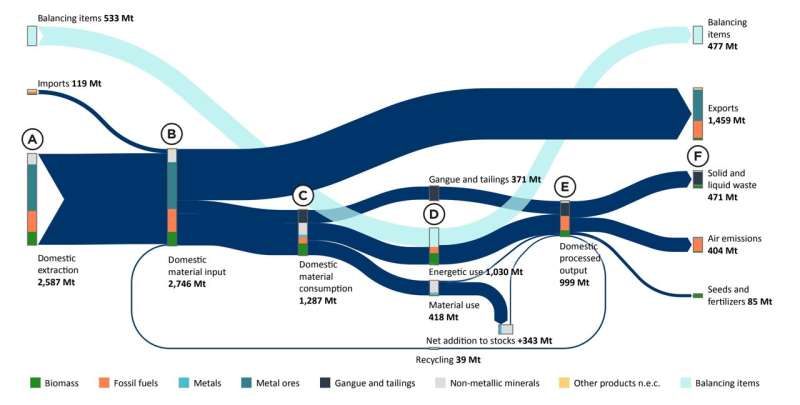This article has been reviewed according to Science X's editorial process and policies. Editors have highlighted the following attributes while ensuring the content's credibility:
fact-checked
trusted source
proofread
New report reveals Australia's material use and circular rate

Australia's national science agency, CSIRO, has released a new report on the country's material use, highlighting opportunities to transition to a more circular and sustainable economy.
The "Australian material flow analysis to progress to a circular economy" report details how Australia uses its resources, linking human consumption to environmental impacts, which can inform approaches to resource efficiency, waste minimization, and greenhouse gas abatement.
It found that Australia's circularity rate—the measure of efficiency in which resources are reused and recycled within a system—is half (4 percent) that of the global average (8 percent).
CSIRO scientist and report author Dr. Alessio Miatto said Australia's material footprint refers to the total amount of raw materials required to support the country's goods and services.
"Over the last decade, Australia has successfully reduced its material footprint, increased its circularity rate, and curbed air emissions," Dr. Miatto said.
"However, the Australian economy uses four times the materials to fulfill each person's needs compared with the world average."
"Australia's circularity rate has increased marginally, from 3.5 percent in 2015 to now closer to 4 percent. However, it remains at half the global average."
"These metrics highlight opportunities to transition to a more circular and sustainable economy."
The report used data on economy-wide material flows for 2019 to provide insights into Australia's circular economy potential.
It found that housing and transport make up half of Australia's material footprint, with food responsible for another 22 percent.
"In 2019, Australia extracted and harvested 2,587 million tons of materials. These virgin materials were supplemented with 119 million tons of imports and 39 million tons of domestically recycled materials. More than half of these materials were exported to other countries," Dr. Miatto explained.
Dr. Heinz Schandl, who leads CSIRO's circular economy research, said Australia could double its circularity rate if we were to employ circular economy opportunities in housing, mobility, food, and energy provision.
"We need to consider efficiencies in the way we measure, process, and use our materials. Australia currently recycles 39 million tons of materials, which is about half of all materials captured through municipal, industrial, and construction waste schemes. The other half is going to landfill, which is a lost opportunity," Dr. Schandl said.
"To bolster circularity, we need to focus on increasing our recycling output. We also need to rethink how we use materials, from designing products that use less material to schemes that extend the lifetime of products."
Material use is the single largest determinant of energy use and emissions, responsible for over 50 percent of global warming, and therefore serves as a big lever to reduce emissions.
Adopting circular economy principles would result in cleaner air, soil, and water. Less material being extracted and ending up in landfills would improve resource efficiency, reduce pollution, and avoid greenhouse gas emissions.
"The re-use and recycling of goods will provide longevity for goods and foster local jobs," Dr. Miatto said.
"Adopting local circular supply chains are also more resilient to supply interruptions and other economic shocks than the capital-intensive global supply chains that favor virgin materials."
The Australian material flow analysis to progress to a circular economy report is part of CSIRO's Circular Economy for Missions initiative, which aims to solve some of Australia's biggest challenges. The initiative aims to support Australia's transition to a circular economy by reducing waste, supporting economic and job growth, and reducing adverse environmental and health impacts from waste production and disposal.
More information: Report: Australian material flow analysis to progress to a circular economy
Provided by CSIRO




















